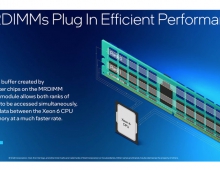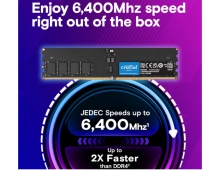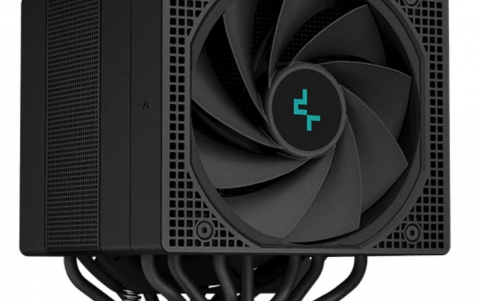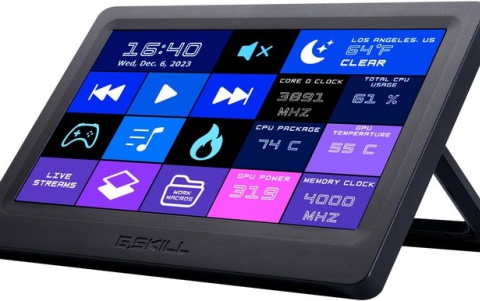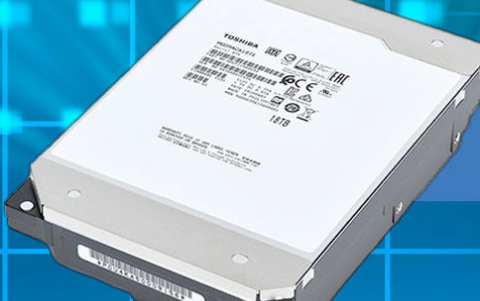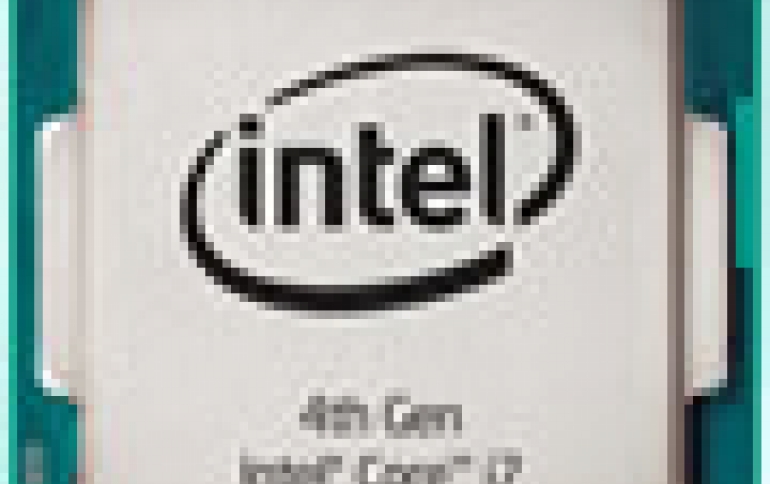
Intel Haswell Processors are Here
Intel has decided to launch the first batch of its fourth-generation
"Haswell" quad-core processors for laptops and desktops prior to their official presentation at Computex.
The Intel Haswell chips will include quad-core and dual-core chips with
hyperthreading support.
Acer, Asustek, MSI and Dell are all exoected to announce PCs, tablets and hybrid systems at Computex.
The family also features an integrated voltage regulator designed to significantly reduce power consumption while eliminating other integrated circuits from the motherboard. Intel says this feature will give laptops 50 percent more battery life compared to laptops powered by its previous generation Ivy Bridge CPUs. In idle or standby mode the chips can extend battery life by up to 20 times, according to Intel.
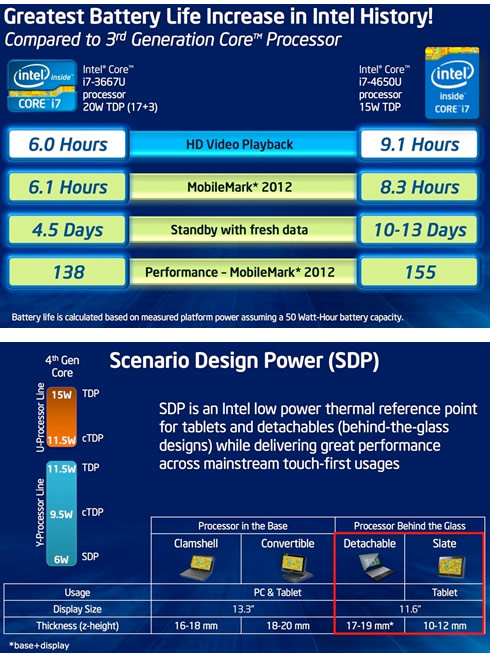
With Haswell, Intel is intrducing the a new specification, SDP (scenario design power), that indicates how much power a computer must be able to dissipate while being used for media consumption and "light creation." Intel will use the SDP spec for CPUs powering tablets and notebooks with detachable displays.

Mobile Haswell processors with TDPs of 15 and 28 watts (or SDPs of six watts or less) feature a Platform Controller Hub (PCH) integrated into the same package. The PCH is what we have known so far as 'Southbridge.' Integrating the Southbridge into the CPU package reduces the size of the motherboard, allowing for smaller and thinner notebook designs that consume less power. These same parts will be capable of operating at a very low-power state that Intel has dubbed SOix. A notebook in this idle state will consume almost no power, but will wake up to a fully active state within milliseconds.
Haswell chips also bring improvements is in graphics. According to Intel the chips will get up to a two times boost in graphics. The graphics processor within the chips will support up to 4K displays.
While Sandy and Ivy Bridge featured two different GPU implementations (GT1 and GT2), Haswell adds a third (GT3):

Haswell GT1 is called Intel HD Graphics, Haswell GT2 is HD 4200/4400/4600. Haswell GT3 at or below 1.1GHz is called HD 5000. Haswell GT3 capable of reaching the 1.3GHz is called Iris 5100, and finally Haswell GT3e (GT3 + embedded DRAM) is called Iris Pro 5200.
Intel has also chosen to call a "sub-slice" its building block the company uses in order to scale up/down to hit various performance and power targets. AMD calls theirs a Compute Unit, while NVIDIA's is known as an SMX.
Haswell's GPU also supports DirectX 11.1, OpenGL 4.0 and OpenCL 1.2.
The graphics performance of the Iris Pro 5200 - the most powerful GPU core found in the Haswell chips - performs equally or slower than an Nvidia GeForce GT 650M mobile GPU. And since Nvidia is already offering the GT 750M, Haswell should not pose any imminent threat to NVIDIA's position in gaming notebooks. On the other hand, Haswell's GPU consumes significantly less power, which is translated in a longer battery life for mobile devices.

Intel on Saturday announced five Core i7 mainstream laptop processors and 12 quad-core Core i7 and i5 desktop chips. Dual-core Haswell chips will be announced on June 4 at the Computex trade show in Taiwan.

The compay is branding Haswell parts as Core i3, Core i5, and Core i7. Intel has also introduced new desktop and mobile chipsets, dubbed Z87 and Q87, respectively.
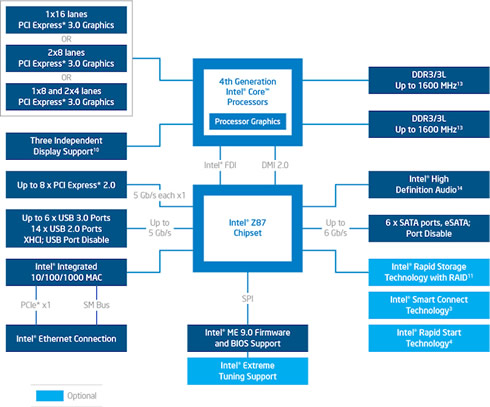
The 8-series chipsets bring support for up to six SATA 6Gbps and USB 3.0.

Intel has broken down its quad-core laptop chips into M-series, which has three new processors, and the H-series. The prices mentioned are in units of 1,000:
The $378 Core i7-4800MQ and $568 4900MQ chips draw 47 watts of power and are clocked at 2.7GHz and 2.8GHz respectively, with maximum clock speed of 3.7GHz and 3.8GHz respectively. The fastest M chip is the $1096 Core i7-4930MX, which draws 57 watts, and has a base frequency of 3GHz that tops out at 3.9GHz. The chips include Intel 4600 graphics, and the company expects 13 new M chips to be introduced this year.
The H-series mobile processors includes the $468 Core i7-4850HQ, which has a base frequency of 2.3GHz scaling to 3.5GHz. The $657 Core i7-4950HQ has a frequency of 2.4GHz scaling to 3.6GHz. The chips draw 47 watts of power and have the high-end Iris Pro Graphics. Intel said it would release six new H chips this year.
The quad-core desktop chips are priced between $192 and $339. The chips are clocked between 3.0GHz and 3.9GHz, have up to 8MB of cache, and draw between 35 to 84 watts of power. The fastest chip is an unlocked $339 Core i7-4770K chip, which draws 84 watts and has a clock speed between 3.6GHz and 3.9GHz.
At the desktop side, Intel today announced the following chips:
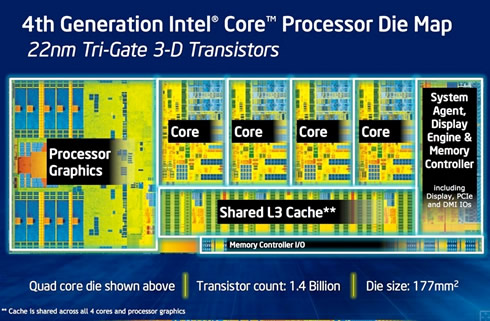
The desktop Core i7 parts feature Hyper-Threading Technology. The fastest chip is the the K-series 4770K, with its unlocked multiplier and slightly higher base clock speed. Base core clocks as well as maximum Turbo Boost clocks are dictated by the TDP.
The GT2 graphics configurations should be slightly faster than the last generation HD 4000 in graphics workloads, except from the the i7-4770R, which is also the only chip that comes in a BGA package.

In addition, all the i7 chips support AVX instructions, Quick Sync, AES-NI, PCIe 3.0, and Virtualization Technology.
The Core i5 lineup does not include Hyper-Threading. There aren?t any Iris or Iris Pro Core i5 desktop parts and all of the above CPUs are using the GT2 graphics configuration. The K-series part also lacks vPro/TXT/VT-d support but comes with an unlocked multiplier.
As fas as overclocking is concerned, most of the voltage regulation being moved on-package, although motherboards still expose all of the same voltage controls that you're used in vy Brodge. Haswell doesn't change the overclocking limits put in place with Sandy Bridge. All CPUs are frequency locked, however K-series parts ship unlocked. A new addition is the ability to adjust BCLK to one of three pre-defined straps (100/125/167MHz). The BCLK adjustment gives you a little more flexibility when overclocking, but you still need a K-SKU to take advantage of the options.

In ay case, it is true that Haswell has been designed with mobile in mind, meaning that it is really no more of an overclocker compared to Ivy Bridge. You can't get significantly additional frequency headroom at marginal increase to CPU voltage. On the other hand, you get more performance and a better platform at roughly the same prices as Ivy Bridge.
Acer, Asustek, MSI and Dell are all exoected to announce PCs, tablets and hybrid systems at Computex.
The family also features an integrated voltage regulator designed to significantly reduce power consumption while eliminating other integrated circuits from the motherboard. Intel says this feature will give laptops 50 percent more battery life compared to laptops powered by its previous generation Ivy Bridge CPUs. In idle or standby mode the chips can extend battery life by up to 20 times, according to Intel.

With Haswell, Intel is intrducing the a new specification, SDP (scenario design power), that indicates how much power a computer must be able to dissipate while being used for media consumption and "light creation." Intel will use the SDP spec for CPUs powering tablets and notebooks with detachable displays.

Mobile Haswell processors with TDPs of 15 and 28 watts (or SDPs of six watts or less) feature a Platform Controller Hub (PCH) integrated into the same package. The PCH is what we have known so far as 'Southbridge.' Integrating the Southbridge into the CPU package reduces the size of the motherboard, allowing for smaller and thinner notebook designs that consume less power. These same parts will be capable of operating at a very low-power state that Intel has dubbed SOix. A notebook in this idle state will consume almost no power, but will wake up to a fully active state within milliseconds.
Haswell chips also bring improvements is in graphics. According to Intel the chips will get up to a two times boost in graphics. The graphics processor within the chips will support up to 4K displays.
While Sandy and Ivy Bridge featured two different GPU implementations (GT1 and GT2), Haswell adds a third (GT3):

Haswell GT1 is called Intel HD Graphics, Haswell GT2 is HD 4200/4400/4600. Haswell GT3 at or below 1.1GHz is called HD 5000. Haswell GT3 capable of reaching the 1.3GHz is called Iris 5100, and finally Haswell GT3e (GT3 + embedded DRAM) is called Iris Pro 5200.
Intel has also chosen to call a "sub-slice" its building block the company uses in order to scale up/down to hit various performance and power targets. AMD calls theirs a Compute Unit, while NVIDIA's is known as an SMX.
Haswell's GPU also supports DirectX 11.1, OpenGL 4.0 and OpenCL 1.2.
The graphics performance of the Iris Pro 5200 - the most powerful GPU core found in the Haswell chips - performs equally or slower than an Nvidia GeForce GT 650M mobile GPU. And since Nvidia is already offering the GT 750M, Haswell should not pose any imminent threat to NVIDIA's position in gaming notebooks. On the other hand, Haswell's GPU consumes significantly less power, which is translated in a longer battery life for mobile devices.

Intel on Saturday announced five Core i7 mainstream laptop processors and 12 quad-core Core i7 and i5 desktop chips. Dual-core Haswell chips will be announced on June 4 at the Computex trade show in Taiwan.

The compay is branding Haswell parts as Core i3, Core i5, and Core i7. Intel has also introduced new desktop and mobile chipsets, dubbed Z87 and Q87, respectively.

The 8-series chipsets bring support for up to six SATA 6Gbps and USB 3.0.

Intel has broken down its quad-core laptop chips into M-series, which has three new processors, and the H-series. The prices mentioned are in units of 1,000:
| Intel Haswell Core i7 M-Series Mobile Processors | |||||
| Model | Core i7-4930MX |
Core i7-4900MQ |
Core i7-4800MQ |
Core i7-4702MQ |
Core i7-4700MQ |
| Cores/Threads | 4/8 |
4/8 |
4/8 |
4/8 |
4/8 |
| CPU Base Freq | 3.0 |
2.8 |
2.7 |
2.2 |
2.4 |
| Max SC Turbo | 3.9 |
3.8 |
3.7 |
3.2 |
3.4 |
| Max DC Turbo | 3.8 |
3.7 |
3.6 |
3.1 |
3.3 |
| Max QC Turbo | 3.7 |
3.6 |
3.5 |
2.9 |
3.2 |
| TDP | 57W |
47W |
47W |
37W |
47W |
| HD Graphics | 4600 |
4600 |
4600 |
4600 |
4600 |
| GPU Clock | 400-1350 |
400-1300 |
400-1300 |
400-1150 |
400-1150 |
| L3 Cache | 8MB |
8MB |
6MB |
6MB |
6MB |
| DDR3/DDR3L | 1600 |
1600 |
1600 |
1600 |
1600 |
| vPro/TXT/VT-d | Yes |
Yes |
Yes |
No |
No |
| Intel SBA | No |
No |
No |
Yes |
Yes |
| Price | $1096 |
$568 |
$378 |
||
| Intel Haswell Core i7 H-Series Mobile Processors | |||||
| Model | Core i7-4950HQ |
Core i7-4850HQ |
Core i7-4750HQ |
Core i7-4702HQ |
Core i7-4700HQ |
| Cores/Threads | 4/8 |
4/8 |
4/8 |
4/8 |
4/8 |
| CPU Base Freq | 2.4 |
2.3 |
2.0 |
2.2 |
2.4 |
| Max SC Turbo | 3.6 |
3.5 |
3.2 |
3.2 |
3.4 |
| Max DC Turbo | 3.5 |
3.4 |
3.1 |
3.1 |
3.3 |
| Max QC Turbo | 3.4 |
3.3 |
3.0 |
2.9 |
3.2 |
| TDP | 47W |
47W |
47W |
37W |
47W |
| HD Graphics | Iris Pro 5200 |
Iris Pro 5200 |
Iris Pro 5200 |
4600 |
4600 |
| GPU Clock | 200-1300 |
200-1300 |
200-1200 |
400-1150 |
400-1150 |
| L3 Cache | 6MB |
6MB |
6MB |
6MB |
6MB |
| DDR3/DDR3L | 1600 |
1600 |
1600 |
1600 |
1600 |
| vPro/TXT/VT-d | Yes |
Yes |
No |
No |
No |
| Intel SBA | No |
No |
Yes |
Yes |
Yes |
| Price | $657 |
$468 |
|||
The $378 Core i7-4800MQ and $568 4900MQ chips draw 47 watts of power and are clocked at 2.7GHz and 2.8GHz respectively, with maximum clock speed of 3.7GHz and 3.8GHz respectively. The fastest M chip is the $1096 Core i7-4930MX, which draws 57 watts, and has a base frequency of 3GHz that tops out at 3.9GHz. The chips include Intel 4600 graphics, and the company expects 13 new M chips to be introduced this year.
The H-series mobile processors includes the $468 Core i7-4850HQ, which has a base frequency of 2.3GHz scaling to 3.5GHz. The $657 Core i7-4950HQ has a frequency of 2.4GHz scaling to 3.6GHz. The chips draw 47 watts of power and have the high-end Iris Pro Graphics. Intel said it would release six new H chips this year.
The quad-core desktop chips are priced between $192 and $339. The chips are clocked between 3.0GHz and 3.9GHz, have up to 8MB of cache, and draw between 35 to 84 watts of power. The fastest chip is an unlocked $339 Core i7-4770K chip, which draws 84 watts and has a clock speed between 3.6GHz and 3.9GHz.
At the desktop side, Intel today announced the following chips:
| Intel Haswell Core i7 Desktop Processors | ||||||
| Model | Core i7-4770K |
Core i7-4770 |
Core i7-4770S |
Core i7-4770T |
Core i7-4770R |
Core i7-4765T |
| Cores/Threads | 4/8 |
4/8 |
4/8 |
4/8 |
4/8 |
4/8 |
| CPU Base Freq | 3.5 |
3.4 |
3.1 |
2.5 |
3.2 |
2.0 |
| Max Turbo | 3.9 (Unlocked) |
3.9 |
3.9 |
3.7 |
3.9 |
3.0 |
| Test TDP | 84W |
84W |
65W |
45W |
65W |
35W |
| HD Graphics | 4600 |
4600 |
4600 |
4600 |
Iris Pro 5200 |
4600 |
| GPU Max Clock | 1250 |
1200 |
1200 |
1200 |
1300 |
1200 |
| L3 Cache | 8MB |
8MB |
8MB |
8MB |
6MB |
8MB |
| DDR3 Support | 1333/1600 |
1333/1600 |
1333/1600 |
1333/1600 |
1333/1600 |
1333/1600 |
| vPro/TXT/VT-d/SIPP | No |
Yes |
Yes |
Yes |
No |
Yes |
| Package | LGA-1150 |
LGA-1150 |
LGA-1150 |
LGA-1150 |
BGA |
LGA-1150 |
| Price | $339 |
$303 |
$303 |
$303 |
$303 |
|
| Intel Haswell Core i5 Desktop Processors | ||||||
| Model | Core i5-4670K |
Core i5-4670 |
Core i5-4670S |
Core i5-4670T |
Core i5-4570 |
Core i5-4570S |
| Cores/Threads | 4/4 |
4/4 |
4/4 |
4/4 |
4/4 |
4/4 |
| CPU Base Freq | 3.4 |
3.4 |
3.1 |
2.3 |
3.2 |
2.9 |
| Max Turbo | 3.8 (Unlocked) |
3.8 |
3.8 |
3.3 |
3.6 |
3.6 |
| Test TDP | 84W |
84W |
65W |
45W |
84W |
65W |
| HD Graphics | 4600 |
4600 |
4600 |
4600 |
4600 |
4600 |
| GPU Max Clock | 1200 |
1200 |
1200 |
1200 |
1150 |
1150 |
| L3 Cache | 6MB |
6MB |
6MB |
6MB |
6MB |
6MB |
| DDR3 Support | 1333/1600 |
1333/1600 |
1333/1600 |
1333/1600 |
1333/1600 |
1333/1600 |
| vPro/TXT/VT-d/SIPP | No |
Yes |
Yes |
Yes |
Yes |
Yes |
| Package | LGA-1150 |
LGA-1150 |
LGA-1150 |
LGA-1150 |
LGA-1150 |
LGA-1150 |
| Price | $242 |
$213 |
$213 |
$213 |
$192 |
$192 |

The desktop Core i7 parts feature Hyper-Threading Technology. The fastest chip is the the K-series 4770K, with its unlocked multiplier and slightly higher base clock speed. Base core clocks as well as maximum Turbo Boost clocks are dictated by the TDP.
The GT2 graphics configurations should be slightly faster than the last generation HD 4000 in graphics workloads, except from the the i7-4770R, which is also the only chip that comes in a BGA package.

In addition, all the i7 chips support AVX instructions, Quick Sync, AES-NI, PCIe 3.0, and Virtualization Technology.
The Core i5 lineup does not include Hyper-Threading. There aren?t any Iris or Iris Pro Core i5 desktop parts and all of the above CPUs are using the GT2 graphics configuration. The K-series part also lacks vPro/TXT/VT-d support but comes with an unlocked multiplier.
As fas as overclocking is concerned, most of the voltage regulation being moved on-package, although motherboards still expose all of the same voltage controls that you're used in vy Brodge. Haswell doesn't change the overclocking limits put in place with Sandy Bridge. All CPUs are frequency locked, however K-series parts ship unlocked. A new addition is the ability to adjust BCLK to one of three pre-defined straps (100/125/167MHz). The BCLK adjustment gives you a little more flexibility when overclocking, but you still need a K-SKU to take advantage of the options.

In ay case, it is true that Haswell has been designed with mobile in mind, meaning that it is really no more of an overclocker compared to Ivy Bridge. You can't get significantly additional frequency headroom at marginal increase to CPU voltage. On the other hand, you get more performance and a better platform at roughly the same prices as Ivy Bridge.

